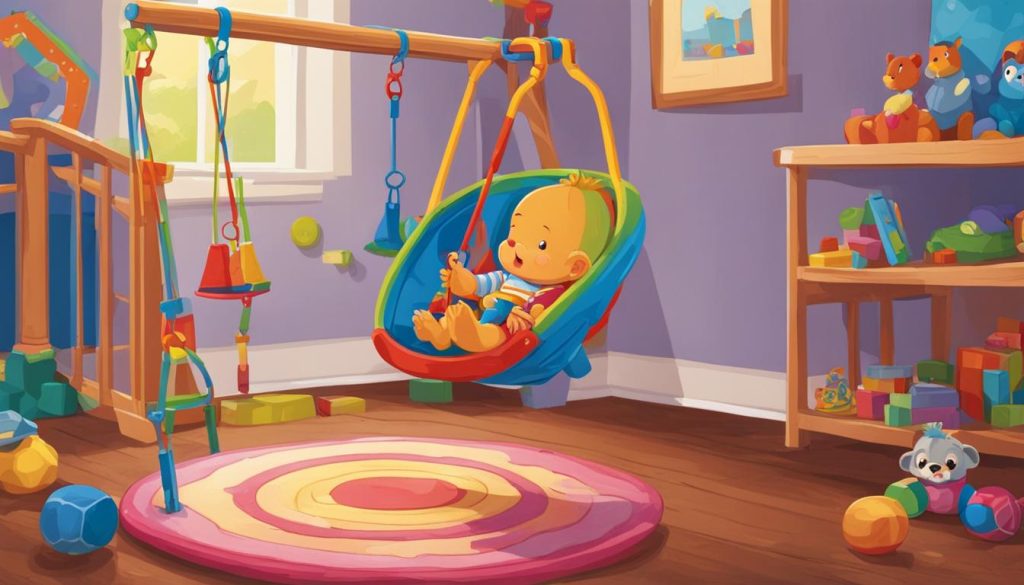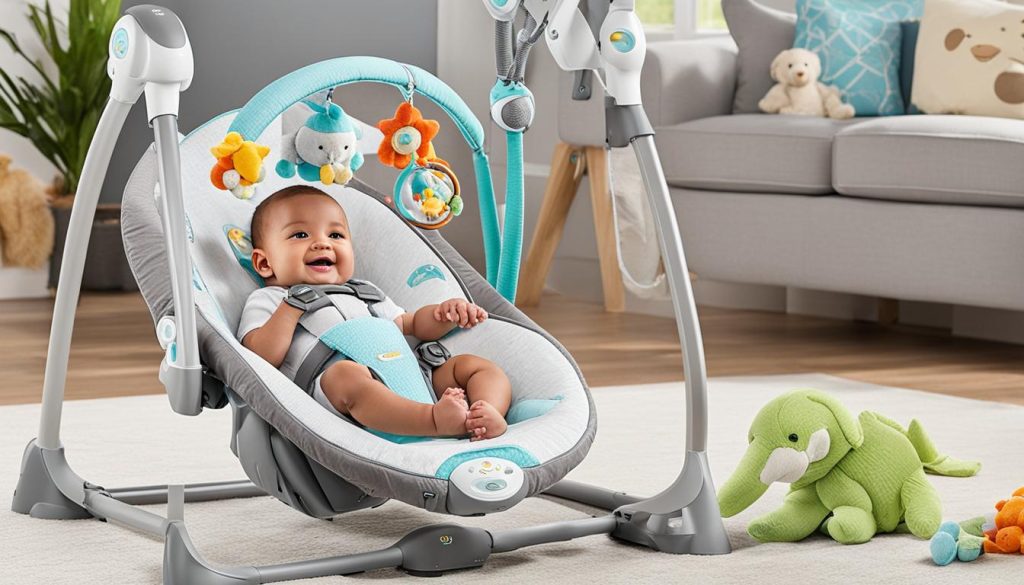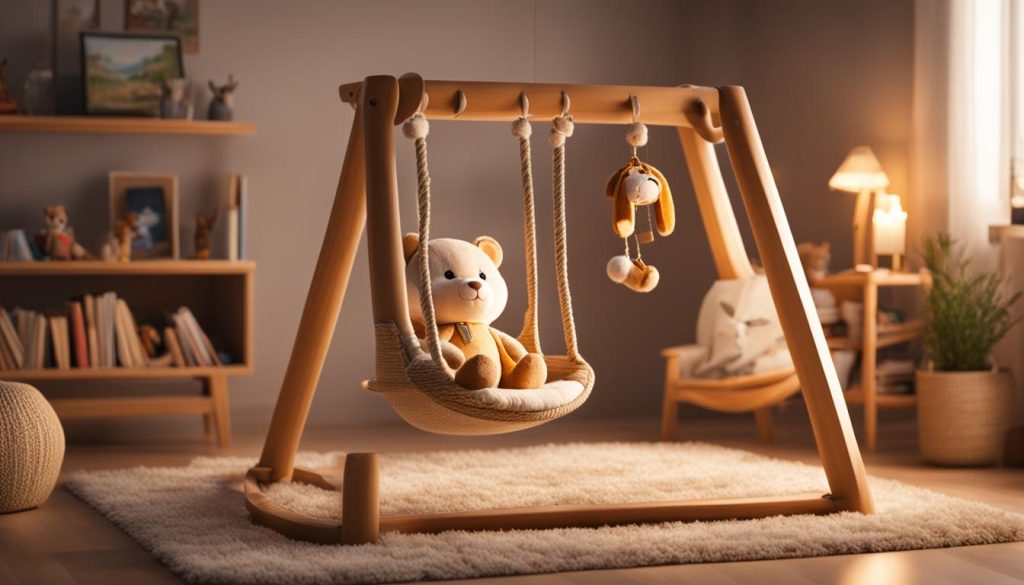Deciding when to stop using a baby swing can be confusing for parents. While baby swings can be beneficial in soothing and entertaining infants, prolonged use can lead to potential health risks. These risks include the possibility of flat head syndrome, Sudden Infant Death Syndrome (SIDS), breathing challenges, and injuries. It is important for parents to be aware of the dangers of overusing baby swings and to adhere to safety guidelines. Additionally, it is crucial to recognize signs that your baby has outgrown the swing, such as physical discomfort and reaching the weight limit recommended by the manufacturer.
Health Risks of Prolonged Baby Swing Use
When it comes to using a baby swing, it’s important for parents to be aware of the potential health risks associated with prolonged use. While swings can be a helpful tool in soothing and entertaining infants, overusing them can lead to various dangers that parents should take into consideration.
Flat Head Syndrome: Prolonged time spent in a baby swing can increase the risk of developing flat head syndrome, also known as positional plagiocephaly. This condition occurs when pressure is consistently applied to one area of the baby’s soft skull, causing it to become flat. To prevent this, it is recommended to limit the amount of time your baby spends in the swing and to alternate positions regularly.
Breathing Difficulties: Extended use of a baby swing can also pose breathing challenges for infants. The semi-reclined position that a swing offers may cause the baby’s head to slump forward, restricting their airway and potentially leading to breathing problems. It is crucial to ensure that your baby’s airway remains clear and unobstructed while using the swing.
Injuries: Another important consideration is the risk of injuries associated with prolonged baby swing use. These injuries can include strangulation, entrapment, suffocation, tip-over, and falling. To minimize the risk of these accidents, it is essential to closely monitor your baby while they are in the swing and to ensure that all safety measures are in place, including using the provided harness and keeping the swing on a stable surface.
| Risks of Prolonged Baby Swing Use | Precautions to Take |
|---|---|
| Flat Head Syndrome | Limit time in the swing, alternate positions |
| Breathing Difficulties | Ensure the baby’s airway remains clear |
| Injuries (strangulation, entrapment, suffocation, tip-over, falling) | Closely monitor the baby, use safety harness and stable surface |
While baby swings can offer convenience and comfort, it is crucial for parents to be aware of the potential health risks associated with prolonged use. By understanding these risks and taking necessary precautions, parents can ensure the safety and well-being of their baby while enjoying the benefits that a baby swing can provide.
Signs Your Baby Has Outgrown the Swing
As your baby grows and develops, there will come a time when they no longer find the baby swing comfortable or appropriate for their needs. It’s important for parents to be aware of the signs that indicate their baby has outgrown the swing.
One of the most noticeable signs is physical discomfort. If you notice that your baby’s head or legs are pressing against the sides of the swing or they seem cramped and unable to stretch out comfortably, it may be time to transition them out of the swing.
Manufacturers often set weight limits for baby swings, typically recommending their use until the child reaches around 6 to 9 months of age. As babies grow and gain strength and weight, they may exceed the swing’s designed capacity. Therefore, it’s crucial to monitor your baby’s weight and adhere to the manufacturer’s recommendations.
Recognizing these signs and being responsive to your baby’s comfort and safety will ensure a seamless transition out of the swing and onto the next stage of their development.
Table: Signs Your Baby Has Outgrown the Swing
| Signs | Description |
|---|---|
| Physical Discomfort | Baby’s head or legs pressing against the sides of the swing or feeling cramped |
| Weight Limit | Baby exceeds the swing’s recommended weight limit |
Recommended Length of Swing Sessions
When it comes to using a baby swing, understanding the recommended length of each swing session is crucial for your baby’s safety and well-being. While there are varying guidelines provided by different sources, it is important to find a balance that works best for your baby.
Some recommendations suggest limiting one swing session to 30 minutes and the total daily time to one hour. Others suggest even shorter sessions of less than 30 minutes at a time. The National Health and Safety Performance Standards guidelines for daycares advise using swings for a maximum of 15 minutes at a time, twice a day at most. These guidelines are in place to prevent potential issues such as cranial flatness and overstimulation.
It’s important to remember that every baby is different, and what works for one may not work for another. Pay attention to your baby’s cues and monitor their comfort level during swing sessions. If you notice signs of restlessness or discomfort, it may be a sign that they’ve had enough time in the swing. Always prioritize your baby’s safety and well-being above all.
| Source | Recommended Length of Swing Session |
|---|---|
| American Academy of Pediatrics | 30 minutes per session, 1 hour per day maximum |
| National Health and Safety Performance Standards | 15 minutes per session, twice a day maximum |
| Parenting experts | Less than 30 minutes per session |
Remember, a baby swing should not be used as a substitute for human interaction or as a sleeping aid. It is recommended to supervise your baby at all times while they are in the swing and to avoid using it for prolonged periods. It’s important to find the right balance between providing comfort and entertainment while ensuring your baby’s safety and development.
Benefits of Using a Baby Swing
Using a baby swing offers numerous benefits for both infants and parents. The gentle, rhythmic motion of the swing can have a soothing effect on babies, mimicking the movements they experienced in the womb. This can help calm fussy or colicky babies, providing a sense of comfort and security. The soothing effects of the swing can also aid in faster sleep onset, helping babies settle down for naps or bedtime more easily.
Furthermore, baby swings can provide a pleasant and enjoyable experience for infants. The swinging motion can be entertaining and stimulating, keeping babies engaged and occupied. This can be especially helpful when parents need a moment to tend to other tasks or simply take a break. The gentle rocking motion of the swing can also help babies develop their vestibular system, which plays a crucial role in balance and coordination.
For parents, a baby swing can be a valuable sleep aid. The rhythmic motion can help lull babies to sleep, providing some much-needed rest for both the infant and the caregiver. Additionally, having a safe and comfortable place to put the baby down can be a relief for parents who need a brief respite or a moment to attend to other responsibilities.
| Benefits of Using a Baby Swing |
|---|
| Provides soothing and comforting motion for babies |
| Aids in faster sleep onset |
| Entertains and stimulates infants |
| Helps develop the vestibular system |
| Serves as a sleep aid for babies |
Soothing Effects of a Baby Swing
“The gentle, rhythmic motion of a baby swing can have a soothing effect on infants, recreating the familiar movements they experienced in the womb. This can help calm fussy babies and provide a sense of comfort and security.”
– Dr. Emily Johnson, Pediatrician
Safety Precautions and Considerations when Using a Baby Swing
When it comes to using a baby swing, safety should be the top priority for parents. Here are some important safety precautions and considerations to keep in mind:
- Selecting a safe baby swing: When buying a baby swing, choose one that meets safety standards and has essential features such as a secure harness to keep your baby in place during swinging.
- Ensuring stability: Make sure the swing is sturdy and stable, with a sturdy frame and strong base. This will prevent any tipping or accidents while your baby is using the swing.
- Secure attachments: If the swing comes with playthings or attachments, ensure they are securely fixed and out of the baby’s reach. Loose or unsecured attachments can pose a choking hazard.
- Following manufacturer’s guidelines: Always read and follow the manufacturer’s instructions and safety recommendations carefully. This includes weight limits, recommended use, and any specific precautions for your baby swing model.
Table: Baby Swing Safety Features
| Safety Feature | Description |
|---|---|
| Secure Harness | A harness that keeps the baby securely strapped in the swing, preventing them from falling or sliding out. |
| Sturdy Frame | A strong and durable frame that provides stability and prevents the swing from tipping over. |
| Non-Slip Base | A base with non-slip feet that ensures the swing remains stable on various surfaces. |
| Safe Attachments | Playthings or attachments that are securely fixed to the swing, ensuring they cannot be easily detached or pose a choking hazard. |
| Easy-to-Use Controls | Intuitive controls that are easy to operate, allowing parents to adjust swing speed and motion safely. |
Additionally, it is important to limit the awake time your baby spends in the swing to prevent the development of flat head syndrome. Avoid using the swing for prolonged periods and never use it as a sleeping aid for your baby. Continuous adult supervision is necessary to ensure your baby’s safety while using the swing. Always stay nearby and keep an eye on your little one to prevent any accidents or injuries.
By following these safety precautions and considering the necessary safety features when selecting and using a baby swing, you can provide a safe and enjoyable experience for your little one.
Tips for Buying and Using a Baby Swing
As a parent, there are some important tips to consider when buying and using a baby swing. These tips will help ensure the safety and comfort of your little one.
When buying a baby swing, it is crucial to choose one that is appropriate for your baby’s weight and age. Check the weight limits specified by the manufacturer to ensure that your baby will be safe and secure in the swing. Testing the swing in the store is also recommended to ensure that it is built to last and has important safety features, such as a fully reclining seat and secure straps.
Using a baby swing properly is equally important. Be aware of the room’s temperature and dress your baby accordingly to prevent overheating. Continuous monitoring of the baby’s comfort is essential, so make sure to adjust the swing’s settings as needed. Remember, never leave your baby unattended while using the swing and always ensure that the swing is placed on a stable surface.
In summary, when buying a baby swing, choose one that meets safety standards and is appropriate for your baby’s age and weight. When using the swing, pay attention to the room’s temperature, monitor your baby’s comfort, and never leave your baby unattended. By following these tips, you can provide a safe and enjoyable experience for your little one in the baby swing.





